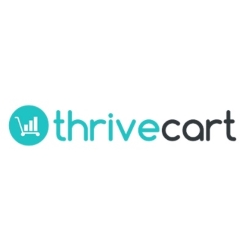Online courses have become increasingly popular in recent years, providing individuals and businesses with the opportunity to share valuable knowledge and generate revenue.
However, with so many platforms to choose from, finding the right one for your course can be a daunting task. That’s why we’re here to compare ThriveCart and Kajabi, the two popular tools in the market.
During our in-depth analysis, we will examine their features, pricing, user experience, course creation and structure, marketing and sales tools, and more.
By the end of the article, you’ll have a clearer understanding of which platform is the better fit for your business needs.
Let’s get started!
Also Read: ThriveCart vs Shopify
ThriveCart
ThriveCart is more than just a shopping cart platform.
Alongside its robust checkout page tools, ThriveCart offers a built-in learning management system (LMS) called Thrive Learn.
This combination allows you to seamlessly sell both physical and digital products while managing your courses effectively.
With ThriveCart, you can create a smooth and intuitive checkout experience for your customers, optimizing conversions and maximizing sales.
If you’re looking for a platform that focuses on enhancing the checkout process, ThriveCart may be the perfect fit for you.
Create high-converting cart pages, funnels, affiliate campaigns, courses and more.
Kajabi
Kajabi provides a comprehensive solution for your online course business. It offers a wide range of features that go beyond course creation and sales.
With Kajabi, you can build a complete digital presence, including email marketing, website building, and more. This all-in-one platform simplifies the management of your online business by providing everything you need in one place.
If you’re looking for a holistic solution to manage and grow your online course business, Kajabi has you covered.
Also Read: SamCart Review
Course Creation & Structure
When it comes to course creation, both ThriveCart and Kajabi offer intuitive drag-and-drop builders, ready-made templates, and the ability to drip-feed content.
However, there are some differences in the features they provide for course creation.
In ThriveCart, the emphasis is on the checkout process, and it offers three basic course layouts to choose from.
These layouts are designed to be simple and effective, providing a streamlined experience for your students. With ThriveCart, you can easily set up your course and start selling in no time.
On the other hand, Kajabi provides more customization options for course creation.
Not only can you design and structure your course using the drag-and-drop builder, but you also have the flexibility to create standalone websites and landing pages.
This allows for a more personalized and branded experience for your students.
Explore: ThriveCart vs 1ShoppingCart
Here’s a quick look at the comparison.
| Features | ThriveCart | Kajabi |
|---|---|---|
| Drag-and-drop builder | ✓ | ✓ |
| Ready-made templates | ✓ | ✓ |
| Ability to drip-feed content | ✓ | ✓ |
| Customization options | Basic | Extensive |
| Ability to create standalone websites and landing pages | – | ✓ |
User Experience & Ease of Use
ThriveCart is widely known for its intuitive and beginner-friendly interface, making it easier for users to navigate and set up their products.
Whether you are creating a course, customizing sales pages, or building carts, ThriveCart offers a seamless and straightforward experience.
Whereas Kajabi provides a more customizable platform with advanced features and options. While this level of customization can be beneficial for those who have specific design preferences, it may require a steeper learning curve for beginners.
Kajabi’s interface offers more flexibility in terms of design and content organization, making it a preferred choice for those who prioritize customization.
Having a visually appealing and user-friendly interface plays a significant role in providing a smooth and enjoyable experience for both course creators and learners.
The right platform for you will depend on your comfort level, design preferences, and overall goals for your online course business.
Create high-converting cart pages, funnels, affiliate campaigns, courses and more.
Marketing & Sales
Both ThriveCart and Kajabi provide a range of marketing and sales features to help you effectively promote and sell your courses.
Let’s take a closer look at the unique offerings of each platform:
ThriveCart
ThriveCart focuses on optimizing the checkout process, ensuring a seamless and high-converting experience for your customers. Here are some of the marketing and sales tools you can expect:
| Marketing | Sales |
|---|---|
| One-click upsells: Increase your average order value by offering additional products or upgrades with just one click. | Order bumps: Encourage customers to add complementary products or services to their cart during the checkout process. |
| Retargeting: Re-engage potential customers who have shown interest but haven’t completed their purchase. | Affiliate integration: Set up affiliate programs to incentivize others to promote and sell your courses. |
Explore: SamCart Free Trial
Kajabi
Kajabi offers a comprehensive suite of marketing and sales tools that go beyond the checkout process. Here are some key features:
| Marketing | Sales |
|---|---|
| Fully-featured email marketing: Nurture your leads and communicate with your audience through targeted email campaigns. | Customizable sales funnels: Build dynamic sales funnels to guide potential customers through your course offerings. |
| Membership sites and communities: Create exclusive membership sites and online communities to enhance the learning experience for your customers. | Advanced analytics: Gain insights into your sales performance and customer behavior to optimize your marketing strategies. |
Affiliate Programs & Integration
Both ThriveCart and Kajabi provide users with the option to create affiliate programs and integrate them seamlessly into their online course businesses.
While both platforms offer affiliate features, ThriveCart stands out with its user-friendly interface and comprehensive set of tools.
ThriveCart’s built-in affiliate asset hub makes it effortless for users to provide affiliates with promotional materials, such as banners, email swipe copies, and social media assets.
The centralized hub streamlines the affiliate process and ensures that affiliates have everything they need to effectively promote your courses.
Furthermore, ThriveCart offers extensive customization options for affiliate experiences. You can tailor the branding, messaging, and commissions specific to each affiliate, allowing for a more personalized and targeted approach.
In addition, ThriveCart enables you to choose how you want to pay your affiliates, giving you flexibility in deciding between one-time commissions, recurring payments, or a combination of both.
Kajabi, on the contrary, has a more basic affiliate system that requires manual work for paying affiliates and lacks the same level of customization options.
While it still allows you to create an affiliate program, the process may be more time-consuming and less intuitive compared to ThriveCart.
Also Read: Creating s Shop With SamCart
Create high-converting cart pages, funnels, affiliate campaigns, courses and more.
Support & Resources
When it comes to support and resources, both ThriveCart and Kajabi offer options to assist you along your online course-building journey.
Let’s take a closer look at what each platform has to offer.
ThriveCart
ThriveCart provides responsive support to address any questions or concerns you may have. Their support team is dedicated to helping you navigate the platform and solve any issues that may arise.
In terms of resources, ThriveCart offers a comprehensive knowledge base that covers various topics related to using the platform.
You can find helpful articles, video tutorials, and frequently asked questions to guide you through the process of building and selling your online courses.
Also Read: SamCart vs Kartra
Kajabi
Kajabi goes above and beyond when it comes to support. They offer live chat support, allowing you to get immediate assistance from their team of experts.
The real-time support can be invaluable when you need quick answers or troubleshooting help. In addition to live chat support, Kajabi also provides an extensive library of resources.
Their knowledge base includes step-by-step guides, video tutorials, and best practice articles to help you maximize the potential of the platform.
Pricing & Membership Options
When it comes to pricing and membership options, ThriveCart and Kajabi offer different approaches that cater to varying business needs and budgets.
ThriveCart
With ThriveCart, you have the option of a one-time fee for lifetime membership.
The Standard Lifetime plan costs $495, making it an attractive choice for those who plan to sell courses in the long term.
This upfront payment eliminates the need for monthly or yearly subscriptions, providing a cost-effective solution for entrepreneurs.
If you want more features, you can upgrade anytime to their pro plan at $690. (One-time payment)
Explore: SamCart vs Paypal
Create high-converting cart pages, funnels, affiliate campaigns, courses and more.
Kajabi
Kajabi follows a tiered pricing structure starting at $55 per month. It has four plans in all, and the highest plan costs $319/month. Note that these prices are for annual payments whereas the monthly payments will require you to shell out more.
For the latest on pricing though, check out the pricing page here.
Kajabi offers a comprehensive all-in-one platform that covers not only course creation but also email marketing, website building, and more. The recurring monthly cost ensures access to ongoing support, updates, and new features.
Also Read: SamCart vs Thinkific
Key Differences at a Glance
| ThriveCart | Kajabi | |
|---|---|---|
| Focus | Optimizing checkout process | All-in-one business platform |
| Features | One-click upsells, order bumps, retargeting | Course creation, email marketing, website building, and more |
| Pricing | One-time fee for lifetime membership starting at $495 | Tiered pricing starting at $55 per month |
| User Experience | Intuitive and beginner-friendly interface | More customization options, steeper learning curve |
| Marketing and Sales | Optimizing checkout process | Email marketing, customizable sales funnels, membership sites, and communities |
| Integration | Extensive integrations with popular tools | Integration options available, not as extensive |
| Support | Responsive support team | Live chat support, comprehensive library of resources |
Explore: How To Add SamCart To Squarespace?
Conclusion
Both the platforms offer powerful features for creating and selling online courses.
ThriveCart excels in optimizing the checkout process and stands out with its one-time fee for lifetime membership.
On the other hand, Kajabi provides a comprehensive all-in-one solution that includes a wider range of features.
If you prioritize a seamless and optimized checkout experience, consider ThriveCart. However, if you’re looking for an all-inclusive platform with additional features like email marketing, website building, and more, Kajabi is better of the two.















